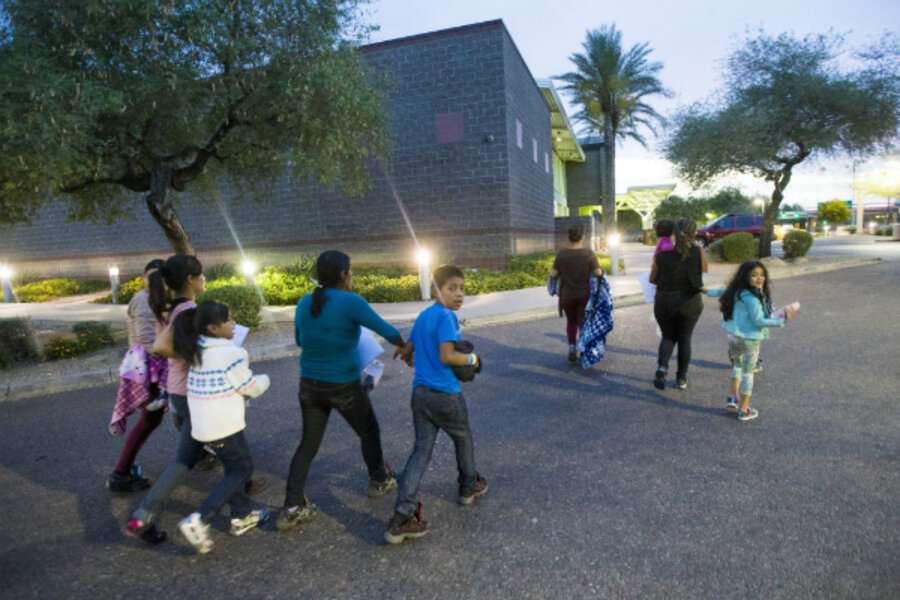Border crisis: Why the surge in illegal border-crossers with children?
Loading...
A recent wave of migrant mothers with children, as well as unaccompanied children, crossing the US southern border is, to President Obama, an “urgent humanitarian crisis." To critics, the surge of humanity on America's doorstep stems at least in part from Mr. Obama's own policies that appear to lay out the welcome mat for illegal immigrants.
With the surge in needy immigrant families, makeshift camps are springing up at Arizona bus depots, and the US is opening military barracks in Texas to house the growing number of unaccompanied children.
According to press reports, rumors are flying throughout Central America that parents won’t be detained by the US Border Patrol if a child is by their side. That's true, for the most part. They are sent to live with relatives, or anywhere else, until their deportation hearings (usually within 15 days).
The Border Patrol, in an internal memo, acknowledges it is having to take its eyes off securing the border and busting human- and drug-trafficking rings in the Rio Grande Valley sector in south Texas to focus instead on a wave of migrants, mostly from strife-torn Central American countries like Honduras, El Salvador, and Guatemala.
After Arizona officials complained about the Border Patrol shipping migrants in from Texas and dropping them at bus stations, the Department of Homeland Security on Friday halted that policy. The US has instead begun housing unaccompanied migrant children on military installations in Texas and California, under the supervision of Federal Emergency Management Agency Director Craig Fugate.
The new wave of illegal immigrants may also affect the politicking in Washington over immigration reform, given that the emerging crisis appears to be drawing into question the government’s ability to contain the border. An adequately sealed border is a key sticking point in negotiations between Democrats and Republicans over a proposed immigration reform measure that includes a path to citizenship for certain illegal immigrants already in the US.
“For those who are friendly to migration, this gets highlighted for the same reason they highlighted DREAM-ers: There’s a very clear moral proposition” around protecting innocent children, says Allert Brown-Gort, an immigration policy expert at the University of Notre Dame, citing a proposed law to give legal status to undocumented young people brought to the US as minors.
“The other side wants to highlight … the idea of migrants on the other side with catapults, just flinging their children across [the border],” because the US has been signaling that it’s become friendlier, under Mr. Obama, to undocumented migrants, Mr. Brown-Gort adds.
Critics say Obama’s 2012 executive order that lets young people brought to the US illegally as children apply for a two-year deferral from deportation, as well as the Bush administration's 2008 decision to close a major detention facility in Texas, have helped to create conditions for a new wave of illegal immigration.
Some migrants are telling reporters on the border that they’ve heard in their home countries that there’s a “new opportunity” to emigrate to the US illegally and stay indefinitely, reports the Los Angeles Times’ Cindy Carcamo on Friday.
“The word has gotten back that [the Obama administration] is letting people stay – not just unaccompanied minors, but women with children – which is creating an opportunity to sneak in and get while the getting’s good,” says Mark Krikorian, director of the Center for Immigration Studies in Washington, which backs "low migration."
“What it means is they haven’t locked down the border, and all this talk about how tough the administration is on enforcement is being exposed as false," he adds.
The border patrol just tripled its projection of how many “unaccompanied alien children” are expected to cross the border. New estimates project 90,000 so-called unaccompanied children will try to cross this year and as many as 165,000 will try in 2015 (up from about 13,000 in 2012 and 24,000 in 2013).
Overall, illegal immigration from Central America is now inching toward 180,000 people a year – about half of the flow at the 2005 peak, but up from 130,000 two years ago.
Children are about 10 percent of that flow, and as many as 70 percent of those children are unaccompanied, Brown-Gort says. Many of the children are 12 and older, and most are boys. At home, boys that age are chief targets of cartels, and rising violence is pushing them to head north.
“It sounds easy to say, ‘Well, they’re being told that all they have to do is show up and everything will be OK,’ but people are balancing that with the really horribly increased dangers of migration,” including shakedowns and sexual violence, he says. “This kind of migration is a big roll of the dice, and not easy.”
Border Patrol Deputy Chief Ronald Vitiello raised alarms about the current policy in an unsigned May 30 memo obtained by the Washington Times and reported by the Associated Press. Releasing mothers with kids and reuniting unaccompanied children with relatives in the US are serving as “incentives to additional individuals to follow the same path,” Mr. Vitiello wrote.
Arizona Gov. Jan Brewer (R) complained in a recent letter to Obama that the policy has resulted in women and children with few connections in the US lingering in makeshift camps while awaiting deportation hearings, including one at the Phoenix Greyhound station. Meanwhile, churches and nonprofit groups have kicked into overdrive to try to keep susceptible families and children fed and safe in the 110-degree desert heat.






